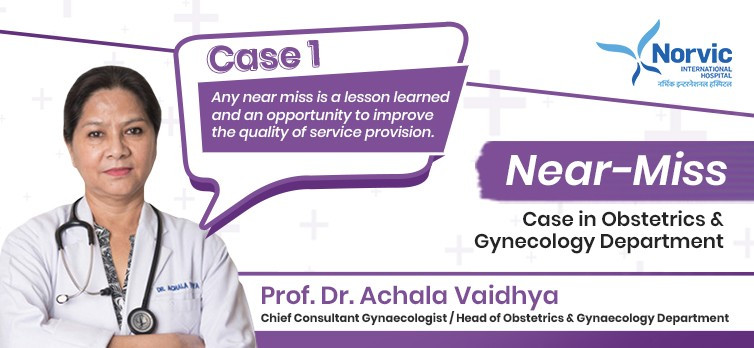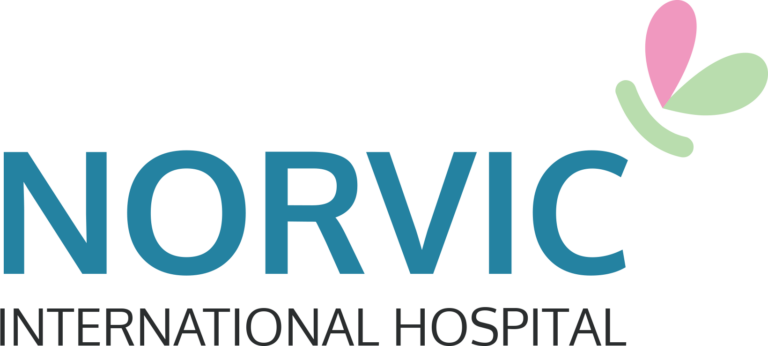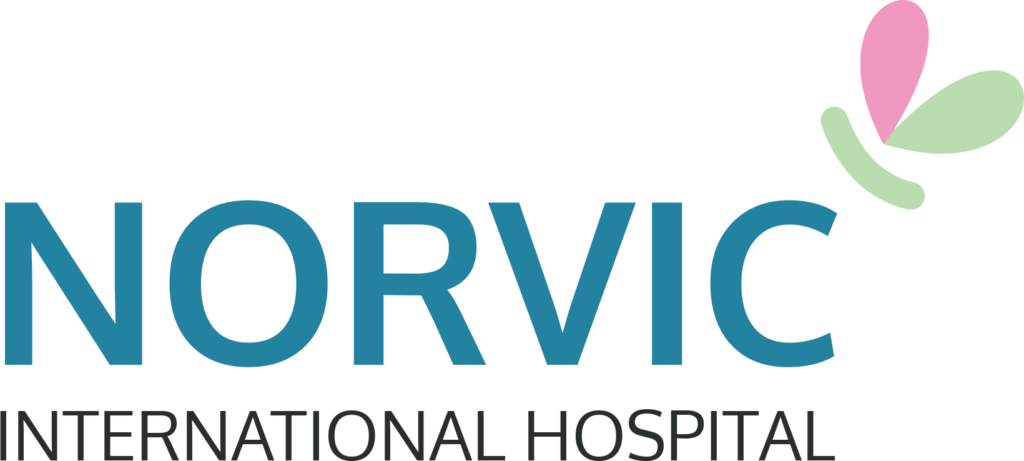Story of A 22 Year Old Female’s Survival | Near-Miss Case 1

According to the World Health Organization (WHO), a maternal near-miss is defined as “a woman who nearly died but survived a complication that occurred during pregnancy, childbirth or within 42 days of termination of pregnancy”.
Norvic International Hospital deals with such cases regularly. Therefore, the Doctors and Nurses of the hospital are very well equipped and experienced to deal with these types of critical cases. Henceforth, whilst providing such services during near-miss scenarios, Norvic has become one of the best Gynecology hospital in Kathmandu, Nepal over time.
Near-Miss Cases cured at Norvic International Hospital
The importance of an increase in near-miss and a decrease in maternal mortality is a good indicator of improved health care facilities in the community. Here we summarize a few near-miss cases which were referred to Norvic International Hospital and were challenging yet gratifying for our professional development but a huge advantage for patients.
Norvic International Hospital handled all these near-miss cases successfully and thankfully there were zero casualties recorded during the time frame. Thus, many near misses cases patients have crowned Norvic International Hospital as the best Gynecology hospital in Kathmandu, Nepal.
Near-Miss Case 1
A 22-year-old married female, primigravidae with a history of 2 months amenorrhea with bleeding per vaginum presented in an emergency at Norvic International Hospital with a referral from a tertiary care hospital.
On presentation, she was in a poor condition with difficulty in breathing, epistaxis, hematochezia, abdominal distension and catheter in situ with haematuria. She was tachycardic with a stable BP of 110/80 mmHg and a maintaining saturation of 92% with oxygen at 8l/min.
On examination, she had decreased bilateral breath sounds, tachycardia and abdominal distension with free fluid. The patient was oriented, did not have a murmur and had a nontender abdomen on admission.
On further history taking, it was discovered that the patient had presented to the tertiary care centre with a history of bleeding per vaginum. The ultrasound had shown an incomplete abortion; hence, a suction evacuation was done and the patient was discharged. In 2 weeks, the patient bled and returned to the tertiary centre.
BHCG was done and was found to be 90,445 IU/mL. On the histopathological evaluation of the product of conception, the report revealed no evidence of Gestational Trophoblastic Disease (GTD).
The patient was curated and discharged home; however, she returned within 2 days due to bleeding. BHCG was done and found to be >1.5 lakhs on 2 occasions 48 hrs apart; a repeat suction and evacuation were done and the patient was discharged.
After 5 days of discharge, she had acute pain in the abdomen, followed by distension. She was admitted to the ICU because of persistent GTD, She was started with single-agent MTX rescue therapy of 4 cycles.
During her chemotherapy, she developed thrombocytopenia with haematuria for which she was managed with multiple types of blood and blood products (PRP, FFP). The medical oncologist was consulted and EMA-CO was planned.
This case was referred to us after 6 weeks in a very critical state. On the day of referral, abdominal tapping was done and the patient was found to have haemoperitoneum. The patient was a case of Hydatiform Mole.
On admission to our hospital, the team of Gynecologists, intensivists and cardiologists collectively monitored the patient. Her BHCG on the day of admission was >10,000 IU/mL.
The patient was in DIC, which was managed with multiple blood and blood product transfusion. USG was done which found und invasive mole with 5 mm myometrium invaded with bilateral theca lutein cysts with mild to moderate ascites (likely hemoperitoneum) in addition to bilateral pleural effusion. Echo found global hypokinesia of LV with EF-20-25% with Mild MR. RA/RV was mildly dilated with moderate TR.
After stabilizing her DIC, she was started on MTX on day 4 of admission, but following 1st dose, she developed focal seizures so MTX was stopped. The CT scan was normal. On day 6 of admission, she complained of acute pain in the lower abdomen with difficulty on breathing.
A repeat USG and CECT abdomen were suggestive of invasive mole with enlarged uterus with invading myometrium, gross ascites suggestive of haemoperitoneum, bilateral theca lutein cyst and b/l pleural effusion with cardiomegaly with pericardial effusion.
Given perforating invasive mole with uncontrolled haemorrhage, Total Abdominal Hysterectomy was planned with a very high-risk consent stating death on OT table. The findings on surgery were a uterus with a size of 18 weeks with anteriorly and posteriorly perforated with molar tissue visible, with bilateral theca lutein cyst 10×10 cm each; hemoperitoneum of 2500 ml was noted. Postoperatively, she was managed with the team effort of the anaesthetist, cardiologist and Gynecologist.
She improved dramatically within a week and her BHCG was 4499 IU/mL. She received one cycle of single therapy of MTX with folinic acid and she was monitored every fortnight with serum BHCG.
She received seven cycles of rescue therapy of MTX till her BHCG level was less than 5 IU/ml. She received two more cycles of MTX thereafter and her BHCG levels were monitored monthly for a year, which remained negative.
Our team effort at Norvic saved a young girl’s life, suffering critically with a case of perforating mole with DIC by performing a total abdominal hysterectomy with further supportive management.
Discussion
The near-miss case definition was used on validated specific criteria comprising five diagnostic features: haemorrhage, hypertensive disorder of pregnancy, dystocia, sepsis and anaemia. For poor resource setting, near-miss is based on near-miss management ICU, need for transfusion,near-miss clinical criteria (P.E.T, PPH) and organ dysfunction.
A review of several near-miss cases has highlighted the deficiency and as well as positive elements to improve obstetric care in any health system. Maternal near-miss cases are investigated over maternal death as –near-miss is more common than maternal death, likely to yield useful information on the same pathway that leads to severe morbidity and death, investigating the care received.
Any near miss is a lesson learned and an opportunity to improve the quality of service provision.
Obstetric emergencies occur suddenly and unexpectedly endangering the life of the mother and representing the quality of obstetric care. We have presented three different types of near-miss cases presented at our emergency with the classical presentation of hemorrhagic complication in perforating mole, uterine rupture, obstructed labour all requiring hysterectomy which avoided maternal death.
The management of all the cases requires a team effort, immediate resuscitative effort, evaluate the cause of haemorrhage and transfer to ICU. All of our patient’s delays in referral, lead to worsening of the condition and surgical intervention resulted in serious morbidity leading to a near-miss situation.
Near miss, the review is the tool for maintaining the quality of maternal services in developing countries because the persistently high level of maternal mortality has overshadowed the severe obstetric complication from which lessons could be learned.
The severe maternal outcomes can potentially be reduced by applying evidence-based interventions for life-threatening complications, improving referral systems and optimizing the use of critical care.
Best Gynecology Hospital in Kathmandu, Nepal
There are lots of hospitals that oversee near-miss cases in the country. However, we have something that no other hospitals have and that is our doctors and nurses. Our Obstetrics and Gynaecology doctors and nurses bear high experience and extensive knowledge regarding near-miss cases and have handled countless such cases throughout their careers.
Nevertheless, we have the best Gynecologist doctors in Kathmandu, Nepal. Some of our doctors even have won various awards and are well renowned when it comes to Obstetrics and Gynaecology.
You can book an appointment via calling us on 01-5970032. Or else, you can simply text us on WhatsApp or Viber on 9880888000. Our team are at your service 24/7 and will guide you through the appointment process and book one for you. We are one of the best Gynecology hospital in Kathmandu, Nepal for a reason and we host the team of Best Gynecologists Doctors in Kathmandu.
Read case study of similar Near-Miss Case handled by Dr. Achala Vaidya herself and her team. The case is about a 31 Year Old Female facing uterine rupture in gasping state.


